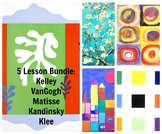Vincent Van Gogh Art Lesson K - 3rd Grade Art History Almond Blossoms
- PDF
What educators are saying
Also included in
- This art lesson bundle is a great resource to introduce your student to five different artists. This bundle includes Henri Matisse, Ellsworth Kelly, Paul Klee, Wassily Kandinsky and Vincent Van Gogh. The lesson is perfect for K through 5th grade with some variations. Students will have the opportuniPrice $6.50Original Price $9.00Save $2.50
- This bundle includes 3 comprehensive art history lessons with built in art projects for the students to have the opportunity to paint in the likeness of Vincent Van Gogh. Vincent Willem van Gogh was a Dutch Post-Impressionist painter who became one of the most famous painters after his death. ThePrice $6.50Original Price $9.00Save $2.50
Description
This lesson plan introduces your students to Artist Vincent Van Gogh. The lesson is perfect for Kindergarten through 3rd grade. Students will have the opportunity to work with paint, use stamping techniques and try their hand as a designer.
The lesson will invite the child to create a beautiful unique art piece based on the painting created by Mr. Van Gogh titled "Almond Blossoms." The student will also gain a basic understanding of the life of the artist.
You can use this lesson in the following ways:
- a unit on the art of Vincent Van Gogh
- a 30 minute sub plan
- a unit on basic painting techniques
- a introduction to the many ways artists create, expanding the student's awareness to art in different mediums
- a handy lesson for any time you want your students to work on stamping and line drawing
What you will find inside the lesson:
- Teacher prompts for you to read as you give the lesson making it EASY to teach!
- Glossary of art terms
- Brief discussion of each topic that is simple and easy to comprehend
- Questions to ask the students about the art
- Step by step DETAILED instructions for an art project with FULL COLOR pictures.
- INSTRUCTIONS ON HOW TO CONFORM THIS LESSON TO COMMON CORE STANDARDS
- Art work to show as examples
- Comprehension questions Worksheet for you to extend the learning that feature key facts about each art project
- Word search and/or coloring page for fast finishers
- Worksheet where students have the opportunity to give you feedback about the projects
What teachers are saying:
-This is one of my favourites in the spring!
-love it!
Make sure to click the GREEN STAR near my store name so that you can stay in touch with my store. I create new lessons every week.




